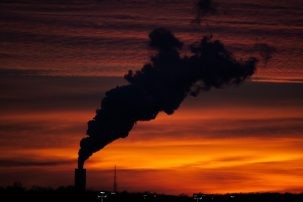Coronavirus Has a Strong Ally: Pollution
Research suggests that even a small increase in long-term exposure to fine particles leads to an increase in the mortality rate of up to 8 percent.

While the medical community is struggling to find a solution to the pandemic that surrounds our society, other areas of science focus on what environmental factors may be helping the disease to spread and become more deadly.
It is not yet clear how environmental factors can influence the contagion and the course of the disease. Given the strong link between respiratory diseases and deaths due to COVID-19, some of the questions that many experts are trying to answer are: What is the relationship between air pollution and the number of deaths related to COVID-19? Can air pollution contribute to the spread of the virus?
To answer these questions, scientists had to wait for sufficient data to be available and the first studies on the topic were reported in several scientific journals. In an article published in Science of the Total Environment, the authors examine the relationship between long-term exposure to nitrogen dioxide (NO2, a highly toxic pollutant generated by cars and other combustion) and coronavirus mortality in Italy, Spain, France and Germany. The results show that 78 percent of the deaths (out of 4,443 total deaths) occurred in those areas with the highest NO2 concentrations in combination with atmospheric conditions that prevented an effective dispersion of pollution. The areas in question include Northern Italy, one of the areas hardest hit by COVID-19. This is in agreement with another study, published in the journal Comprehensive Clinical Medicine, in which the authors write: “This research shows how the Regions of Northern Italy, which have been the hardest hit by Covid-19, are also those with a high concentration of particulates (PM10 and PM2.5) which reached values in February above those established by legislative standards.”
Another study, led by Francesca Dominici, director of the Harvard Data Science Initiative, created quite a stir, stating that even a small increase in long-term exposure to fine dust leads to an increase in the COVID-19 mortality rate by up to 8 percent. According to the research, areas with higher historical pollution levels could experience higher pandemic mortality rates. “We have a virus that affects our lungs and I think it is quite undeniable for this to happen,” said Dominici. “Not giving priority to addressing air pollution “seems like an unwise decision,” she added.
Air pollution may not only be responsible for the increase in deaths related to COVID-19, but also for its spread. In a letter sent to MedRxiv magazine, a group of scientists focused on understanding whether the virus could be transported by air pollution The results confirmed the presence of SARS-CoV-2 genetic material on the pollutant particles, suggesting that conditions of atmospheric stability and high concentrations of particulates could favor the persistence, and therefore the spread, of the virus in the atmosphere. The results have been declared “preliminary” by the same authors and other tests are currently underway. If confirmed, the news reveals another face, hitherto unknown and in the shadows, of the relationship between COVID-19 and air pollutants: no longer just agents of death but also promoters of the spread of the virus.
To encourage the dissemination of scientific results during the pandemic, many journals allow you to view the works before they are subjected to the rigorous method of scientific review, which guarantees their robustness in terms of results and methodologies but which can delay publication for a period ranging from a few months to more than a year. While we must wait for the articles to receive the seal of scientific credibility, the data on which many of these works are based are shared online to promote the transparency of the results. In addition, the scientific papers published so far generally agree that air pollution can be a cause of the increase in deaths related to COVID-19 and can promote its persistence in the air and, therefore, its spread.
Satellite images showed us only a few months ago that nitrogen dioxide emissions in some areas of China had decreased by 30 percent. Unfortunately, new data show that the levels of nitrogen dioxide and fine dust in April in the same regions are slightly higher compared to the values of the past year. The same fate could befall other countries.
Scientists’ efforts become futile if scientific information is not translated into action to protect public health. The scientific community continues its race to provide the necessary tools to those who govern us not only to face the emergency of COVID-19 during this delicate phase, but also to plan a future in which today’s choices help to solve problems in the future, instead of exacerbating them. This depends on each and one of use as well as on those who are ruling our countries and shaping our everyday life more than ever.
Adapted and translated from an article originally published in La Repubblica.
Marco Tedesco is a research professor at Columbia University’s Lamont-Doherty Earth Observatory.
